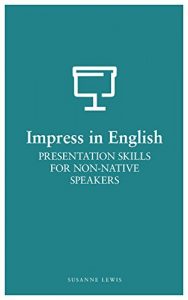Presentation skills for Non-native Speakers
Matterhorn Languages
Susanne Lewis
ISBN 9781977034779
Review for EFL Magazine by Steve Hirschhorn
 It seems to me that public speaking and associated skills are becoming ever more important to language students, whatever their age. For that reason this little book provides a very welcome addition to current literature on the topic. And it is a small book, only 71 pages but packed with all kinds of useful, real-world and insightful tips.
It seems to me that public speaking and associated skills are becoming ever more important to language students, whatever their age. For that reason this little book provides a very welcome addition to current literature on the topic. And it is a small book, only 71 pages but packed with all kinds of useful, real-world and insightful tips.
The book is divided into 11 chapters, each dealing with a different aspect of managing a public presentation.
The chapters include such titles as:
Your Style, The Audience, Grammar, Structure and Useful Phrases, and Body Language. The writing style is fluid and most importantly, the text is graded so that the proposed non-native speaker reader will be able to follow. It is refreshing to find plain English used where it can be of most value.
As usual with these reviews, I will take a chapter at random and examine it in more depth. In this case, Chapter 3, called Cultural Aspects.
This chapter starts with a number of intriguing questions concerning the background culture of the intended audience; whether they might be individualists or collectivists, whether they own resources or share, whether subordinates are expected to obey or be consulted and so on. There are thought-provoking questions which may cause a presenter to reflect on their own opinions as they consider each one, given that quite often people assume that everyone shares their own views on certain issues!
Lewis has included an exercise section or two in each chapter and in Chapter 3, readers are invited to consider the implications of the nationalities attending their presentation and to create a ‘country comparison tool’; she also offers an online source to assist with the reader’s research.
Chapter 3, like the other chapters finishes with a ‘top tips on…;a section which offers a handy summary of the previous text.
Scanning this work provides a fascinating oversight of the contents; how we use language for simplicity, how to manage a glitch, ensuring congruence between verbal and body language, preparing for questions and much more.
Lewis has provided a handy list of useful structures as well as an overview of tenses and their functional use. I think it’s fair to say that this clear, straightforward section is representative of the author’s commitment to creating an accessible work, an endeavour in which she succeeds, beyond doubt.
Overall, this little book punches well above its weight in the most positive of ways. It’s crammed with information of use to anyone, native or non, who gives presentations or speaks in public.
It also holds useful information for teachers themselves in the sense that advice on many aspects of presentation can be transferred into managing a class of students!
We have all been to presentation in which the presenter talked to the screen, read direct from the screen, mumbled, employed unnecessarily convoluted language, used body language which was in conflict with the spoken words and had no contact with the audience. Now you know what to recommend they should read; carry a copy of this book so that you can drop it off as a gift at the end!
In conclusion, this is a great little book, which everyone who speaks to groups should read. It won’t take very long and it’ll be worth it!
Steve Hirschhorn (Budapest, February 2018)




